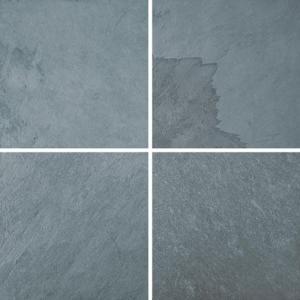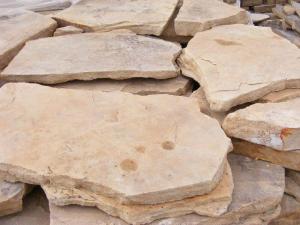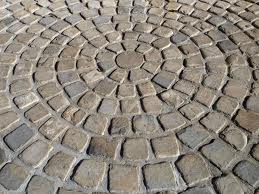Our research was focused on Stone. Information about the characteristics, typical application, and benefits of each of the following stones is included below: bluestone, flagstone, granite, limestone, sandstone, and slate.
BLUE STONE
Bluestone is a blue-gray sandstone consisting of a mixture of sand compound and quartz particles. Bluestone is flame treated to create a pebbled uniform surface. Thermal treated bluestone pavers are ideal for non-slip surfaces and are therefore safe for high traffic areas.
Natural cleft bluestone pavers have a non-uniform surface. This creates a more natural look, in regards to the color and texture of the bluestone. Natural cleft is a hard wearing stone and can stand up against the harshest weather. Bluestone can also vary in color from blues and grays, to brown, green, yellow, rust and at times purple. This variance in color shades is dependent on the depth at which the bluestone is quarried. The quality and texture of the bluestone is also directly impacted by the depth of the quarry. Pennsylvania Bluestone is a common type.
Typical applications: patios, walkways, garden paths and pool decking, fireplaces and steps.
Benefits of Bluestone Pavers
- Bluestone pavers are a very durable and versatile building material, due to its hard and dense composition.
- Bluestone pavers are safe to use around the pool, for they have a non-slip finish to them.
- Bluestone is often called ‘slate’, because it is the flattest stone of all the natural stones, making it very easy to install.
- Bluestone pavers can be purchased in varying thicknesses and dimensions, something suitable for all types of applications.
- Bluestone pavers will add natural beauty to your property, giving it that classical, ‘ancient’ aesthetic appeal.
- Bluestone pavers are available in so many different colors. There is bound to be the right color to match any of your existing materials.
FLAGSTONE
Flagstone is a sedimentary rock that is split into layers along bedding planes. Flagstone is usually a form of a sandstone composed of feldspar and quartz and is arenaceous in grain size (0.16mm – 2mm in diameter). The material that binds flagstone is usually composed of silica, calcite, or iron oxide. The rock color usually comes from these cementing materials. Typical flagstone colors are red, blue, and buff, though exotic colors exist. Arizona flagstone is a common type.
Typical applications: patios, walkways, garden paths and pool decking, fireplaces and steps.
GRANITE
By definition, granite is an igneous rock with at least 20% quartz by volume. Granite usually has a medium- to coarse-grained texture. It can be pink to gray in color, depending on their chemistry and mineralogy. Granites sometimes occur in circular depressions surrounded by a range of hills, formed by the metamorphic aureole or hornfels. Granite is usually found in the continental plates of the Earth’s crust. Granite is nearly always massive (lacking internal structures), hard and tough, and therefore it has gained widespread use as a construction stone.
Typical applications: paving hard surfaces, driveways, walkways, patios and pools
Granite paving shapes:
- Fan
- Hexagonal
- Diamond
- Concourse Square
- Half Course Square
- Marquise
- Cobble-lock
Benefits:
- Granite resists corrosion, scratching, and heat
- Can be used in very high traffic areas
- Not influenced by freeze-thaw cycles in outdoor applications
- Provides a natural acoustical barrier
- Granite is an all natural material and each piece is unique
- More durable than virtually any synthetic flooring surface
- Will not fade
- Easy cleaning and maintenance
- Harder than concrete and steel.
LIMESTONE
Limestone comes in a variety of types and colors. It also has different finishes. It can be hammered, polished, honed, grooved, tumbled, and fine picked. Limestone cut into blocks and slabs of varying dimensions (dimension stone) and used as: curbstone, paving stone, treads, coping, pool corners, sinks, and in fountains.
Limestone is also commonly crushed and used as a construction material in road base and railroad ballast, as an aggregate in concrete, and mixed with shale to make cement. It is also crushed and laid down for pathways.
Limestone is formed from calcium carbonate to create the mineral known as calcite. Some of the commonly used types of limestone include: chalk, coquina, fossiliferous, lithographic, oolitic, travertine, and tufa. Calcite is vulnerable to acid, and therefore limestone degrades from rainwater over time, which is slightly acidic.
Typical Applications
- walkway, courtyard, stepping stones, and pool area
- beautiful material
SANDSTONE
Sandstone is a sedimentary rock made up of small bits of sand sized sediment, usually containing quartz, feldspar, and lithic fragments. Bluestone and flagstone are types of sandstone. Sandstone comes in a variety of colors including: tan, brown, yellow, pink. It is often striped and swirled, evident of layers of sand compacted into the stone. Sandstone is porous, allowing water to percolate through and even be stored within it. Sandstone is a common paving material and has been used since ancient times as a building material. Sandstone is cut into blocks and slabs to be used for paving and building.
Typical Applications
- walkways, patio flooring, walls and wall features
Benefits
- durable
- versatile
- very long lasting
- easy to install
- slip resistant
SLATE
Slate is shale that has undergone metamorphism. It is made up of silt and clay sized particles and includes quartz, feldspar, and other minerals such as pyrite and hematite. It is laminated- made up of many thin layers- and fissile- easily splits along the lamination lines. Slate comes in many colors, mostly light to dark grey but also includes: purple, green, red, and brown. The color is determined by small amounts of materials being present in the shale. For example, shale would be red because of the presence of iron oxide. Slate is cut into blocks and slabs to be used for paving, cladding, and roofing tiles.
Typical Applications
- pathways, patios
Benefits
- strong material, strength of concrete with more appealing surface
- easily cut with straight edges and uniform thicknesses
- unaffected by acid, can be placed directly into the soil
- slip resistant
RESOURCES:
Geology.com, http://www.tulane.edu/~sanelson/geol212/sandst&cong.htm, http://www.paversearch.com/bluestone-pavers-menu.htm, http://www.paversearch.com/bluestone-pavers-introduction.htm, http://en.wikipedia.org/wiki/Flagstone, http://www.amlinkmarble.com/paver.htm, http://www.paversearch.com






